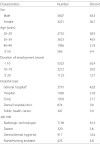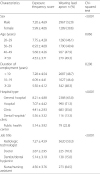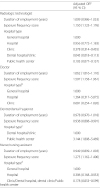1. Lim HS. Health disorders caused by physical factors among health care workers-focusing on ionizing radiation. J Korean Med Assoc. 2010; 53(6):483–91. DOI:
10.5124/jkma.2010.53.6.483.
2. Korea Centers for Disease Control and Prevention. 2014 Occupational Radiation Exposure in Diagnostic Radiology in Korea. 2015.
3. PHASE II BV. Health risks from exposure to low levels of ionizing radiation. 2006. Washington DC: The National Academies Press.
4. United Nations Scientific Committee on the Effects of Atomic Radiation. Effect of ionizing radiation: UNSCEAR 2006 report to the general assembly with scientific annexes. Vienna: United Nations; 2006.
5. Do KH. The health effects of low-dose radiation exposure. J Korean Med Assoc. 2011;54;(12):1253–61.
6. Parmeggiani L. Encyclopaedia of occupational health and safety. Third (revised) edition. Vol. 1 AK; Vol. 2 LZ. International labour office; 1983.
7. Sander D, Brunner G. Studies on radiation exposure of personnel in endoscopy. Z Gastroenterol. 1992; 30(2):151–5. PMID:
1553832.
8. Singer CM, Baraff LJ, Benedict SH, Weiss EL, Singer BD. Exposure of emergency medicine personnel to ionizing radiation during cervical spine radiography. Ann Emerg Med. 1989; 18(8):822–5. DOI:
10.1016/S0196-0644(89)80204-5. PMID:
2757279.
10. Mojiri M, Moghimbeigi A. Awareness and attitude of radiographers towards radiation protection. J Paramed Sci. 2001;2(4):2–5.
11. Lee HH. Management on radiation exposure of radiological technologist working in medical facilities. 1991. Daegu: Master’s thesis, Kyungpook University.
12. Kim NS. The survey of Radiologic technologist’s sense engaged in Dept. of diganostic radiology about radiation protection. 2000. Gyeongsan: Master’s thesis, Gyeongsan University.
13. Oh SH, Choi SM, Lee MJ, Park KN, Choi SP, Kim YM, et al. Survey of radiation exposure to emergency physicians. J Korean Soc Emerg Med. 2008; 19:541–50.
14. Kim H. Study on the knowledge, perception, and behavior about the protection of workers who have risk of radiation-exposure in hospital. 2001. Seoul: Master’s thesis, Yonsei University.
15. Kang EJ, Lee KH, Ju OJ. A study on the environmental condition and safety in dental radiographic room. J Dent Hyg Sci. 2005; 5:83–8.
16. Noh JS, Lee BH, Bea SY, Park HS, Ryu SY, Park J. Analysis of radiology students’ behavior in wearing radiation protection equipment-based on the theory of planned behavior. J Korea Contents Assoc. 2011; 11(9):443–52. DOI:
10.5392/JKCA.2011.11.9.443.
17. Yoon J, Yoon YS. A survey about the knowledge, attitudes and behavior for radiation safety management of operating room nurse and dental hygienists. J Dent Hyg Sci. 2014; 14(2):230–9.
18. Kang EJ, Hyeong JH. A study on radiation management status and exposure anxiety awareness of dental hygienist. J Dent Hyg Sci. 2015; 15(2):172–81. DOI:
10.17135/jdhs.2015.15.2.172.
19. Lee WJ, Ha M, Hwang SS, Lee KM, Jin YW, Jeong M, et al. The radiologic technologists’ health study in south korea: Study design and baseline results. Int Arch Occup Environ Health. 2015; 88:759–68. DOI:
10.1007/s00420-014-1002-1. PMID:
25408461.
20. Kang SG, Lee EN. Knowledge of radiation protection and the recognition and performance of radiation protection behavior among perioperative nurses. J Muscle Joint Health. 2013; 20(3):247–57. DOI:
10.5953/JMJH.2013.20.3.247.
21. Jeong BS. The Analysis of Factors Influencing on Radiation Safety Management Behavior in Dental Hygienists. 2013. Seongnam: Master’s thesis, Gachon University.
22. Kim SJ. An inquiry into dental personnel’s Knowledge, attitude and behavior about the defense against dental radiation. J Korean Soc Dent Hyg. 2004; 4(1):15–30.
23. Park HH, Rhie J, Jung P, Lee JD, Won JU, Roh J. Radiotechnologists and radiation exposure from PET and PET/CT systems. Korean J Occup Environ Med. 2012; 24(1):86–95.
24. Kim J. Factors affecting radiation protection behaviors among perioperating nurses. 2016. Gwangju: Master’s thesis, Chosun University.
25. Park IS LEEKH. A study on the environmental condition and safety in dental radiography room. J Korean Soc Dent Hyg. 2004; 4(1):49–64.
26. Jeong JY, Han MA, Park J, Ryu SY. Performance and related factors of radiation safety management in dental hygienists. J Korean Soc Dent Hyg. 2016; 16(2):215–24. DOI:
10.13065/jksdh.2016.16.02.215.







 PDF
PDF Citation
Citation Print
Print


 XML Download
XML Download